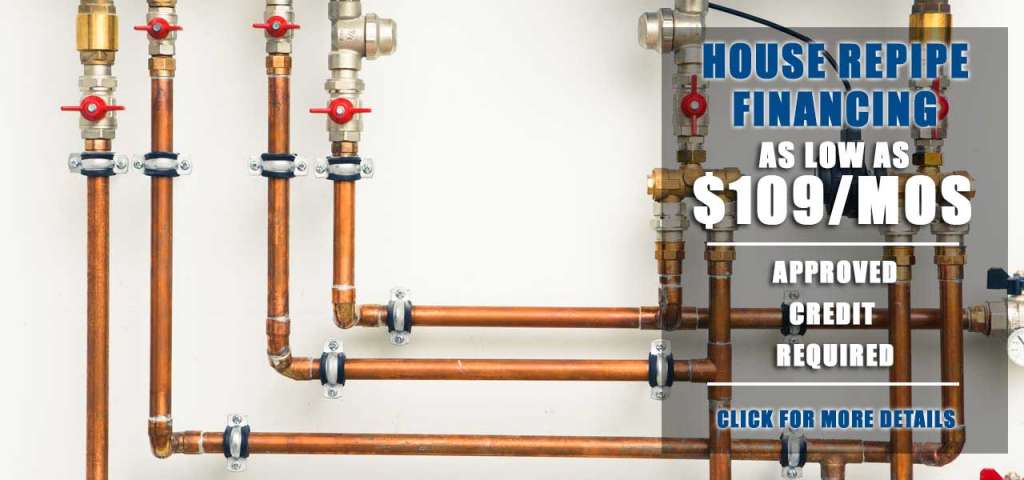Whole House Re-pipe Specialists in Houston
Explore Repiping:
- History of Repiping in Houston
- What is Whole-House Repiping?
- What Materials are Used in Whole House Repipe?
- Will My Homeowner’s Insurance Cover a Repipe?
- Signs That You May Need a Whole-House Repipe
- What Does Repiping a House Involve?
- You’ve Decided on a Whole Home Repipe – What Now?
- How Long Will the Entire Re-piping Process Take?
- When is the Best Time to Repipe My Home?
- How Much Does it Cost to Re-Pipe My Home?
- Things to Look for In Your Repiping Plumbing Company
History of Repiping in Houston
Part of what makes Houston unique is the number of historic-era homes, built as many as 110 years ago. Areas like Houston Heights, Germantown, and Old Sixth Ward even have regulations regarding the maintenance and renovation of historic homes. Owners of these protected properties have strict guidelines to follow when performing any home improvement project. Even new properties built in landmark districts must follow strict guidelines regarding everything from the type of doors or shutters on a home, down to the color of the exterior paint.
The biggest problem with owning a historic-era home, or any home for that matter, is keeping up with the seemingly endless cycle of “maintenance and repair.” As they age, our homes begin to show obvious signs of wear and tear, like fading paint or a patchy, leaky roof, and these “in your face” problems tend to find quick resolutions. Rusting and corroding pipes, pinhole leaks, and cracks in both lines and fittings that occur behind walls and under cabinets can go unnoticed for weeks or months.
Many homes built before the 1940s may still have lead pipes delivering their drinking water, which, as we all know, poses a significant health hazard. Even homes built as recently as the mid-1980s may have lead solder that was used to fuse pipes and fittings; this lead can also find its way into your water supply. The only way to altogether remove the threat of lead is to remove all traces of lead in your plumbing.
Once the potential dangers of lead plumbing became general knowledge in the 1930s, the torch was passed along to galvanized steel pipes. Since steel is a metal, and we all know what happens when you mix metal and water, steel pipes were dipped into a liquid zinc bath that would protect both the outside and the inside of the pipe. It was estimated that galvanized steel pipes would have a lifespan of more than fifty years, which has proven to be mostly true.
Thousands of homeowners in Houston have already completed their whole home repipe. However, thousands of homes around Houston still have galvanized plumbing and continue to suffer from leaky pipes. This is where Nick’s Plumbing Service expert repipe plumbers can help.
What is Whole-House Repiping?
There’s a bit of confusion when it comes to the subject of whole house repipe jobs. By its name, most people assume that a whole house repipe replaces every pipe in your “whole house.” Whole house repiping refers, specifically, to replacing all the water supply lines that come into your home, as well as any “branch” of those pipes that delivers water to any plumbing fixture. When discussing the re-piping of a house, plumbing companies refer to the replacement of all water supply lines only.
Whole-house repiping does not include the replacement of drain pipes or sewer lines. It is important to understand the distinction, as problems with clogged drains, backed-up toilets, or broken sewer lines will not clear up after a repipe job. We know that sounds a bit vague and confusing, so let’s break down the whole house repiping process.
Beginning at the point where the responsibility for the waterline becomes yours, the house side of the water meter, all water supply lines are replaced. From the water meter outlet, the existing water supply lines are removed or bypassed, creating an entirely new plumbing system to deliver water to faucets, dishwashers, toilets, showers, bathtubs, sinks, water heaters, and hose bibbs. Having a whole house repipe service performed does NOT include replacement of your drain or sewer lines.
The whole house repipe also does not refer to faucets, toilets, or other water fixtures installed in your home. Depending on the type of plumbing installed in your older home, now may be the most suitable time to think about a whole house repipe service.
What Materials are Used in Whole House Repipe?
PEX Pipes
Today’s most common house repipe material is PEX pipe, also known by its longer, less memorable name, cross-linked polyethylene. While PEX was introduced to the European market in the 1980s, it wasn’t until the early 2000s that the United States fully embraced it as a replacement for galvanized steel or copper pipes. Since that time, PEX pipe has become the most used type of water supply line in new home construction.
Sourcing the raw materials for PEX plumbing lines is much less expensive than mining, dredging, and refining precious metals like copper and brass. PEX pipes are also easier to install, thanks to their flexibility and the fact that PEX pipe installations do not require any soldering or welding. PEX pipes will not corrode, as there are no metallic compounds in PEX, and they are much less likely to be damaged by freezing temperatures, as their elasticity allows them to expand in cold climates.
PEX plumbing has one major shortcoming, though. It is not recommended for outdoor use, as the sun’s ultraviolet rays can break it down quickly. When PEX is exposed to direct sunlight, it can leech petroleum by-products into your water supply, even for a short period. PEX pipes that are installed outdoors, without any protection from the sun, will harden and crack in a matter of months, causing major leaks.
Copper Pipes
Copper pipes, though much more expensive than PEX, remain a popular option in whole house re-pipes. Since being introduced during the 1930s, copper plumbing lines are recognized for their long lifespan, ease of installation (compared to galvanized steel or lead pipes), and anti-bacterial and anti-microbial properties.
Copper is still the most widely used material for plumbing pipes and fittings throughout the developed world. With an expected useful life of over seventy years, it’s safe to assume copper will be around for a while.
Will My Homeowner’s Insurance Cover a Repipe?
Even though the number one cause against homeowner’s insurance policies every year is water damage caused by catastrophic leaks, whole house re-pipes are not covered under these policies. The apparent logic behind this rule is that insurance policies cover “sudden and accidental” damages and are the direct result of that single incident. While the more pragmatic among us might wonder why taking proactive measures to prevent costly water damage repairs is something to be penalized for, it all comes down to dollars and cents.
Large projects like whole-home re-pipes, or replacing older electrical wiring, or replacing your roof are considered a part of regular home maintenance. For the same reason, your auto insurance policy doesn’t reimburse you for oil changes and replacing the tires; regular maintenance is the owner’s responsibility. In a cruel twist of commerce, while your homeowner’s insurance may be willing to pay out your claim for the first broken pipe, they are less likely to cover subsequent losses if the same line or another pipe in the home breaks. Many homeowners have found their claims denied or their policies canceled because they didn’t address the problem of aging and failing plumbing after the initial incident.
Signs That You May Need a Whole-House Repipe:
Discolored Water
Water that appears cloudy or has a strange odor can be a sign of corrosion in your water supply pipes. As corrosion breaks away from inside the line, it flows into your faucets as tiny flakes of rust. Over time, rusty water can clog up faucet aerators and cause damage to all plumbing appliances.
Water is supposed to be clear when flowing out of a faucet or any other plumbing fixture, so the presence of any color in your water is cause for concern. Grayish, cloudy water can result from having hard water in your area, and tiny mineral particles cause cloudiness. Red or brown water indicates exposed metal in your pipes is eroding and leeching rust into your water supply. Rust-colored stains in your sinks, as well as discolored laundry, can also be a reliable sign that it’s time to perform a repipe.
Low Water Pressure
Decreased water pressure in one area of the home is usually a sign of a water supply line leak somewhere in that area of the house. Reduced water pressure throughout the entire home could signal a leak between the city supply and your home. Supply line leaks are pressurized and will allow thousands of gallons of water to escape in a short amount of time. Minimize the damage to your home and yard; call a licensed and experienced plumbing company when you discover low water pressure.
Repeated Leak Repairs
While a leak in your water supply line can be an isolated event, chances are it isn’t. Galvanized pipes will rust and corrode more frequently in and around pipe bends and fittings, as these areas provide spaces for water to collect and dissolve metal threads. As copper pipes age, they too start to weaken at curves, often with tiny pinhole leaks that eventually become worse over time.
Regardless of the material that makes up your plumbing system, time takes the same toll on all of them. At Nick’s Plumbing Service, we usually employ the “One Leak Rule,” meaning that making a single pipe repair for a leak is a great idea, especially if your plumbing is newer. Beyond that first leak, if we return to fix another leak in the same system, we will usually recommend repiping service.
Your Home Has Lead Pipes
Lead pipes are most often found in homes built before the 1930s, so we don’t run into those very often unless we’re in a historic district like Memorial or the Houston Heights. Your ancient lead pipes may still be servicing your home adequately, but the risks involved with having lead pipes have far outweighed their usefulness for decades.
Lead was outlawed for use in any pipe, fitting, fixture, or flux used in plumbing systems delivering drinking water to residential and non-residential buildings in 1986. Since that time, the adverse health effects in children exposed to lead have become public knowledge, and the substance has been almost completely removed from use. If you are unsure about the presence of any lead pipes in your home, your Nick’s Plumbing technician can inspect your pipes and let you know for sure. Should your plumbing technician discover any lead pipes or fittings currently in use, it is imperative to have them taken out of service.
Your Home Has Galvanized Steel Pipes
The potential dangers of using lead for drinking water delivery were recognized by the plumbing industry as far back as the 1940s. Around that time, a method of using steel pipes dipped into a zinc bath coated the pipes in a corrosion-resistant layer of soft metal. These galvanized steel pipes became the standard for new construction until the 1970s when copper became the flavor of the month. Or decade.
Galvanized steel pipes have been known to last 70 – 80 years, with some cities having even older examples in their networks. The drawback to galvanized pipes is that over time, the protective zinc coating eventually chips away from mineral particles in the water. As soon as any of the zinc coating is removed, the exposed steel beneath it begins to rust, eventually causing the pipe to leak and fail.
Your Water Doesn’t Smell or Taste Right
Drinking water with a foul taste can signify that the metal in your pipes is beginning to break down. Water should taste clean and refreshing, and doesn’t have a natural smell, so the presence of anything remotely moldy, mildewy, or otherwise stale-tasting could be your home telling you it’s time for a whole house repipe.

What Does Repiping A House Involve?
It’s one thing to say repiping a house is a big job. But if, as a homeowner, you don’t know the steps involved in the process, there’s no point in moving forward with the process until you do.
Before Construction
At Nick’s Plumbing, we inspect and provide a cost evaluation for any repiping of a home. We recommend all of our clients to shop around, consult with other licensed plumbers during this stage, and compare prices. Reputable plumbing companies should offer a thorough inspection and written estimate for a total repipe.
If and when you decide to go with a complete house repipe, your licensed plumber will apply for your municipality’s work permit. The next step will involve your plumbers in choosing the best range of materials to install. This will most likely be a consultation process between you, the client, and your plumber.
The Work Begins
During the repiping process, your home’s water service will need to be shut off. At Nick’s, we aim to do most of this work when the customer is out of the house during the day, so your evening schedules aren’t affected.
Licensed plumbers have the tools which allow them to pinpoint the exact locations of pipes behind your walls. Precise holes are cut into your drywall to enable access to your home’s pipes. This isn’t a case where workers come in and cut arbitrary holes throughout your home. These openings allow access to your home’s pipes.
You’ve Decided on a Whole Home Repipe – What Now?
While the effects of a whole-house repipe are comfort, convenience, and confidence in the quality of your plumbing, there is nothing about the process to make you believe it while it’s going on. There’s going to be a lot happening, with one part of the crew focused on locating, disabling, and where it’s feasible, removing the existing pipes. The other part of the team will be measuring, cutting lines, swinging hammers, and firing blowtorches.
During the re-piping process, your home’s water service will need to be shut off for extended periods over a few days. We try to limit the number of water interruptions to the entire home, but on challenging jobs, it may be necessary to turn the water off for the project’s entirety.
Licensed plumbers have the tools which allow them to pinpoint the exact locations of pipes behind your walls. Precise holes are cut into your drywall to enable access to your home’s pipes. This isn’t a case where workers come in and cut arbitrary holes throughout your home. These openings allow access to your home’s pipes. After the installation process has been completed, the installers will carefully patch up the drywall and repaint. The idea is to make your home look as if the plumbers were never there.
How Long Will the Entire Re-piping Process Take?
A couple of days to a full week is usually the approximate timeline we at Nick’s Plumbing provide our customers. Of course, factors like the home’s size, the piping complexity, and how the number of bathrooms, laundry connections, and other unforeseen circumstances can affect that timeline. Repiping a home usually involves building the new piping alongside the existing or aging pipes. Usually, the only time you will be without water is when you begin the process of switching from the old lines to the new.
When is the Best Time to Repipe My Home?
The best time to consider a complete re-piping is when you have old metal piping such as galvanized steel, lead, or aging copper pipes. As steel pipes age, they are more prone to developing leaks, and lead pipes can contaminate your drinking water. Take advantage of a home remodeling by replacing sections of a damaged pipe if your budget won’t allow a full re-piping.
How Much Does it Cost to Re-Pipe My Home?
Of course, the cost to repipe an entire home is going to be dependent on a few key factors, from the size of the house, the number of bathrooms, and the type of piping you choose to install. Additional factors that can increase the cost of a whole-house repipe are opening and repairing walls, floors, and ceilings that must be done to access hidden pipes and the lack of easy access to lines in crawl spaces or attics.
Whole house re-pipes generally run an average of $4,000 – 10,000 for a standard-sized home that installs PEX pipes. All copper installations, larger homes, or homes with several full bathrooms can expect a price tag as high as $20,000.
A whole house repipe can be a messy and inconvenient task, but the added value to your home and personal peace of mind can help take away the sting the job may cause.
When it’s time to consider a whole house repipe, call Nick’s Plumbing Service today for a cost evaluation or a second opinion.
Things to Look for In Your Repiping Plumbing Company
- Strong, positive online presence.
- Multiple reviews over an extended period.
- Good standing with the Better Business Bureau
- Guarantees and warranties for any parts, service, or damage claims that may result from a plumbing company error.
- Provide accurate and thorough estimates, including all components, labor, and incidentals.
Why Trust Nick’s Plumbing with Your Whole House Repipe?
If you’re at a point where you’re considering repipe your home, contact more than one reputable licensed plumber before making any final decisions. They will be able to inspect and provide you with an accurate evaluation of what work needs to be done and its cost.
- Nick’s Plumbing Service has been in business in Houston Heights since 1979.
- Nick’s Plumbing oversees all aspects of your whole house repipe.
- Nick’s Plumbing Service only employs licensed and experienced plumbing technicians to ensure your satisfaction.
- All of Nick’s Plumbing Service technicians are background checked for your safety and security.
If you live in the Houston area, Nick’s Plumbing is among the area’s most trustworthy plumbing and HVAC companies. For the past 40 years, we’ve built a solid reputation as a business that provides reliable customer service and a top-quality product. We look forward to hearing from you.
Whole House Repiping
Nick’s Plumbing Live Video Transcription:
In this weeks Facebook Live Q&A The Potty Mouth Guys discuss why areas that got flooded are prime candidates for a whole house repipe as well as the different types of piping used in house repiping.
How’s it going today? Back at Nick’s Plumbing. This is the, uh, are we going with the potty mouth, potty mouth, potty mouth guys. John Eccles and Richard Saad here for another weekly edition of ask your plumber. Right? So we’re here to answer some questions and um, go over some different plumbing things and see what the world wants to say about it. How are you doing today, Richard?
Fantastic. Yeah, it’s a Thursday and I need to turn my phone off.
There we go. Sorry about that guys. Technical difficulty. It’s okay. It happens. So I believe today we are going to be talking about a water repiping. Is that correct? Yep. Domestic water supply, right? So that’s going to be residential, home, water supply, all this stuff we had, we had a great
question come in first of this week and this has to do with a lot of victims of flooding. I.E. from the Harvey and this call comes in from Michael and he lives right there at memorial and willowcrest crest area. And uh, that’s a seven, seven. Oh, seven, nine zip code. And as everybody is aware of when they released the dams, is when a lot of people over there did flood well, those homes are actually prime targets for a complete whole house repiping. And why is that? You tell me, well built 60 seventies, they’ve got original galvanized in the house, galvanized from the point of installation till today, you can extrapolate how many years that is. The coating has come off on the interior of that galvanized pipe, so that coating now has exposed the steel behind and in that coating is a zinc coating. So when it comes off, it exposes that steel to where, uh, it starts to rust and it starts to close the piping down where your pressure starts getting reduced and your volume starts to get reduced is the bottom line. And from that standpoint, uh, there’s a couple of ways to fix it that we’re going to go over with. But one way is to totally cut it out. And especially if you’ve been flooded, this is a absolute no brainer and you should be not keeping any of your galvanized even though you’re not going to get paid from it. From Fema, you must replace bottom on line.
What is the average lifespan of galvanized piping? Thirty, 40 in good working condition, good water, all that good water. And I’ve been working conditions 30, 40. You’re saying most of these homes in this area that we’re actually answering the question for are um, 60, 70 built. So there definitely beyond the lifespan,
correct? Yeah. Okay. Kinda like cast iron piping. That whole area’s got cast iron piping as well. Absolutely. It’s in the same predicament them Meyer land, Bel air ever. We’re all in that same predicament. And those areas, if it’s original, it’s just time to upgrade. Yes, upgrade, get with the Times. Well, it’s. So let me ask you this. If you are a flooded victim, right? You put your house back and then all of a sudden in a year or two, the piping starts to leak, right? Creates damage. Uh, I don’t think you’re going to be very happy.
No, I’m one of those type of people that we’ve already had one catastrophe. If there’s a chance to avoid another one right now, let’s go ahead and take it and get it out of the way. You
know, my, my mom was, she lives over there and Briar Grove Park and I gave her two leaks. Now she did not get flooded. She’s the one street off of the bayou and did not get flooded, but her galvanized is going out. And last year we repiped her house because I gave her two leaks and that’s my rule of thumb. You get to third one, you don’t get to keep your piping. It goes away. So she got all new piping and let’s kind of go through choices. We all have choices. Hold on. I’m going to have to turn this down. I guess I didn’t do it the first time. Pardon? This commercial break.
Okay. And we’re back and we’re back. Sorry. Uh, but we have choices when we go through repiping. And I want to say one thing on a. If you are a harvey in your house is gutted at this point and the person that’s helping you put things back, they don’t tell you or recommend that you should completely wipe out your domestic water piping. Um, I would think twice about having them do the rest of it. That’s how strongly I feel. So let’s go through some piping. We have pex piping, which is a form of flexible plastic. We’ve got different types of copper type L and type M . And you can go back with galvanized. I would not recommend going back with galvanized though. Um, again, because that product will give out and another 30 or 40 years you’ll be doing the same thing. Now with Pex, there’s three different types of Pex that you use.
You’ve got pex, a, b, and c pex a is the only pex that’s made for direct burial and that is the best pex that you can buy out of all three of those that, that is all we use it Nick’s Plumbing is pex A. So we will direct bury it and we put it in the house because again, it is the best pex that you can buy now on the inside of your house. Uh, on the copper side, you can go with type M or type L . Type L is a thicker copper type M is the thinner copper so people can actually save some money and you think you’re getting a better price from a company. Well, they just switched over to type in and saved money on repiping you’re home and you’re not even aware of it. But if I’m gonna re pipe my home, which I had to repipe my home, I’m in the same predicament that, that whole area is over there.
Uh, I re pipe it in type L, copper. That’s what I chose to use. But it doesn’t mean that’s what you need to use. Pex is a good product. They both are good products right now. Going through that, let’s show them what we brought today. We’ve got three different colors and what you’re looking at, this is actually, this is actually pex A, and you can see, let me grab one. You can see how it’s flexible. Yeah. This has happened. Mentioned these two or three quarter inches, but they’re in different colors. And why is that? This is all Pex a . it’s all the same because they’re patriotic. That’s right. Patriotic. Or are they really meant for dumb plumbing companies that don’t know the difference between hot and cold. So that’s the next. That’s the next issue. That’s right. Now, the only reason this is just dyed. They put blue dye and red dye.
This has no dye. So typically when we read pipe a house, this is all you see us use because we know the difference between hot and cold and we don’t mix hot and cold water lines together, but there are a lot of people and there’s a lot of subs here in town. Uh, there’s companies that you’re seeing advertised on TV that are from California that are in here today. Re piping a lot of homes. They’re using all subcontractors. They have no permanent employees down here in Texas or specifically Houston. They’re the ones probably using this just to make sure they don’t mess up. Yeah. You know, it’s not a bad thing, right? I mean, I’m not saying it’s a bad thing, it just makes it stupid proof. It does. Um, you know, and to me right out the red and blue for homeowners, not a bad thing is I guess what I’m trying to stay.
It allows them to take up in the attic and they know exactly what hot and what is cold. Yeah. Yeah. That’s all one day. So you’re taking up for dumb? No, not at all. Not at all. I’m taking taking. There’s a lot of them. The thing from a customer’s perspective, well, halfway, uh, when you have helpers helping helpers, that’s not a good thing. And you need to do color coded pipe and that’s not good for. No, but I agree from a homeowner’s perspective, uh, if you, if this is important to you to go up in the attic and understand which one’s hot and cold, which we haven’t done 50 plus years, right. Galvanized didn’t tell you that either or copper is not going to tell you that either though. But I, it is an interesting feature. I understand what you’re saying. Now we are your repiping specialist, so our guys are highly trained, efficient, and they can get away and use all this piping because we know the difference between hot and cold and we don’t cross them by mistake.
Some things to be aware of with pex. It’s been on our market in Texas specifically Houston about 14 years now. Well, this is what nobody really knows in the future. What’s going to happen with this piping. Houston changed over the detergents in their water supply and we are no longer on a chlorine system. We are on a chloramines system, so the issue with these detergents is nobody knows what it’s gonna do to this pipe. I can’t tell you, and why can’t I tell you is we don’t have enough data stored up at this point to understand if that detergent is gonna eat this pipe or not. Now in the defense of pex, we don’t know if it’s going to do that to copper either a, we know it’s tearing down galvanized at a higher rate. It is definitely impacting because it’s more corrosive and when the coating comes off of that galvanized, especially over there like memorial wilcrest , all in that 77079 zip code. It is eating that pipe even quicker.
Now. One Way to fix that as you can do a whole house, a chloramines filtration system and that will fix that issue and it will help the deck over day degregation of that piping even further. Yes ma’am. What did that PVC pipe? Is that in house throughout your house and there’s another pipe that I haven’t spoke about that is CPVC and that is what Ursula is speaking about CPVC. Now CPVC is a form of plastic. It’s a rigid plastic meaning it’s not flexible. It’s been out a long time. It is tried and true and we’re under the same problem with our detergents. Again, US using the chloramines, we don’t know what it’s gonna do to that plastic piping either because it is corrosive. We just don’t know. We don’t have the data yet. Umm chloramines only been out for about eight years, so this piping has been out about 14 installed into homes in Houston, so give it another 10, 15 years.
I’m going to be able to have more data to let you know that, okay, this was a huge mistake or not tune back in for that show. Fifteen years down the road. That’s right. As a lead into a followup show, we’ll have to remember that 15 years to do another one of these. Right, so and, and saying this, as a homeowner, I would tell you you need to pick the piping that you’re going to be most comfortable with and I’m comfortable telling you that pex a , I would not use pex B or C absolutely not, but pex a and type L copper and I’m actually okay with type M copper. I have not in my 20 years experience seen very much go wrong with copper M. That usually it’s a grounding problem on the piping. Something’s eating the piping. Something’s touching the piping. If you go back to your days and in chemistry, and I’m taking everybody way back, two dissimilar metals can eat each other depending on what the metals are.
So if something is sitting on top of that copper that shouldn’t be there, well that could be creating an issue in creating what they call electrolysis so that could impact, but that’s the only way that I’ve really seen an impact of, you know, but if you look at the cost between type L and type M, you know, it’s minuscule, but what happens to these homeowners you is, you get a bid and you go out and get several companies to bid and you want copper. Well this company wants your business and they might be higher than another company and they want to do it and they say we’ll match that price. Then they just switch over to type m and you will never know unless you specifically ask. Now again, m is not a bad copper it’s just more thin. And like I said earlier, I did type L in my house. Uh, and that’s all we use here is type L.
What reason would you have, what was your reasoning for going copper versus the pex?
That’s a great question and this is something that nobody knows. The only material that we have left at our disposal that helps fight bacteria and viruses is copper. Copper is a natural killer to those items. Now, will it kill them all? No, but it’s not going to promote the growth of those bacteria and viruses when they come through the water supply. It’s going to help kill them. Now, when you use plastic and plastic is plastic. There is no, we don’t know yet. Well No, there’s nothing in here that is going to help kill pathogens and let’s call him pathogens. Which copper will help deal with that. Okay. Um, what level? I don’t know. I, I’m not in the business of being a doctor, so I don’t know, but I know at some level it does kill pathogens. Okay. So that’s one of the big reasons I went with it. And B, I know it’s going to last a long time. Yes ma’am.
Do you have to worry about busting? You’ve actually read a couple of things. Maybe that’s right, that that answer is yes. Pex A. um, and that’s an interesting question that Ursula brought up when you’re looking at copper versus Pex, copper does not expand and contract like this piping will. This piping can actually freeze and it will actually expand. Once the freeze is over, it will contract back to its original piping structure. Copper galvanized done CPVC Dun Dun. Then yeah, you’re is not going to be a pretty sight one that freezes over. If it did freeze. And this past freeze that we went through in a, what was it, January, you know, it’s, it wasn’t this pipe that was having an issue. No, it was the other three pipes. Absolutely. That we’re having an issue. So that is a great point. So that might swayed your precision. Are Your perception there we go, um, to, to buy this pipe versus the other pipe? Yeah. Whatever
homeowner gets into that mode of, hey, these are going to be some decisions that were going to make, whether it be repiping your home repairing better. The decision is that, you know, it’s just like anybody else, right? We want to take the knowledge which we give a. Then you want to take the benefits that each one’s going to give you. Whichever one works best for you is the one that you want to go with ultimately. Right? Yeah. You know, me personally, I love the fact that, you know, this tends to wear down less in freezing situation. So you, I mean, that’s one other thing you get to kind of check off your list. Oh, we got that in house. We don’t really have to worry about it and that at least not near as much. And like on your end, you know, hey, you know, the, the, uh, the copper, right, having a little bit more of a, a health effect for you was, it was a decision making thing that was more important to me. That’s exactly. So that’s what’s great about our company and Nick’s, is that we just want our customers to be happy with whatever decision they decided.
That’s correct. Yeah. We’re here to help you facilitate that now so you can make an educated decision that’s going to be best for you and your family. Uh, we’re not here to push any piping structure. No, we’re here to make sure that you’re getting what your needs and wants a out of this. Right. And like I said earlier, we are here in Houston, been here since 1979. These other companies that you are seeing on tv as we speak, are coming in from California. They don’t have one permanent employee in the, in this town. And yet, uh, their costs I think is probably cheaper than a lot of us that are stationed here in Houston. Uh, and that’s because they’re subbing everything out. They don’t have the overhead. Uh, so if you choose to get hooked into their, hey, we’re going to warranty it forever and we’re going to be here for you forever well.. you’re not here now.
I mean, that’s my answer for it. You’re not here now. So how are they going to be here for you in the future? I mean, that’s my big concern and question. And I was talking to a friend of mine the other day, he did not hire us to do his. He’s doing a complete re pipe of his house and he’s doing it in pex, but there are a lot of people running around the, a are not qualified b, don’t have the insurances, c are not from Houston or not local. I.E. California again and, and their repiping a lot of these homes and, and he and I had a big discussion about it and, and I helped him through and I was okay with him not hiring us, um, and it was really cheap, you know, and they’re actually doing it over the weekend. I wonder why because they don’t want to get caught by the city I guess. And um, so he’s paying me to go inspect it on Monday and I’m okay with that. I’ll go do that.
So he had someone else do the work. He’s a friend and now he’s going to have you spend it for him to make sure it’s good.
Yeah. But we are the repiping specialist. I mean we are at it, who else is there. Why wouldn’t he have me come look at it? That’s, that’s a good point, right? Oh, we’re just told our time is up and I took the whole time. That’s all right. I hope that we helped, especially in that whole area that that did get hit and his name was Michael. Michael, I hope that we did help you in the decision, but again, I just want to say it one more time. If you did flood FEMA’s not paying you to repipe, but if you’re in the, in a home that’s in this from the seventies or before you must re pipe, you have to. It’s not even a question or option. The option should be which piping are you going to use and who are you going to get to do it? That should be your only question. If you want to talk about it, call me. 713-868-9907 I will help you through the process whether you hire us or not. We’re here for you. We’re here for you. Alright, well that concludes another week of the potty mouth. Guys. Richard Saad, John Eccles. We’ll see you next Thursday. Same time. 11:00 a.m. Uh, there’s more, right? Take care. Have a great week.
Why We’re Houston’s Repipe Specialists
Nick’s Plumbing Live Video Transcription:
And we’re live, from the headquarters. Nick’s Plumbing. I’m back, I was on vacation last week. I’m sure that the show went very well because I watched it and we want to thank Navien for coming on and the Co hosting with Mr Richard Saad here, but back to regular schedule. John Eccles, Richard Saad, the potty mouth guys are back in action and we’re here to talk about, um, some dark, gloomy areas of your home that you don’t go, you don’t see, you don’t pay attention to. It could be one of two different things, right? It could be your attic or the depths below the pier and beam underneath your home if you’re not on a slab house. These are areas that are a neglected by most homeowners. They don’t go in on typically and they don’t see them. So we’re going to talk about what’s in those areas, what’s been neglected and how can we look around and see what’s happening.
Right? So what’s the number one thing that’s in those areas? Mr Saad. Water pipes. Water pipes. That’s exactly right. That’s a huge one. What’s number two? Water heater. Your water heaters? Water heaters are hidden. Don’t see them man attic, we know they’re not underneath the house and the attic. Yes, absolutely. And you can even have gas pipes on occasion, right? Absolutely. Um, and so this is something that’s kind of near and dear to our heart because here at Nick’s plumbing, we are Houston’s premier repipe specialists, right. We, uh, we take a lot of pride in that and so we got a lot of experience with it. Right. So let’s talk about it. So water pipes, when they’re neglected, especially in the Heights, Memorial, West U, Bellaire, those older parts of Houston. What are those water pipes typically made out of galvanized pipe and is that good pipe to have to a certain point of time?
Fifty years ago it was a. yeah, it was very. There is a time limit on those pipes. Right? So especially when we’re specifically talking about water, just like everything else in the world, technology times a evolution, things change, things get better. And, and nowadays for water piping there is much better options than galvanized wouldn’t you say? I would. What’s your favorite? I’m still a big copper guy. I mean, I, I’m a copper guy, would my galvanized went out in my house? Well, I took it out before it went out, but I, I went all copper and I think there’s a, I think there’s a Nomar in our society now where everybody hears that, oh, copper, so expensive. Copper is this and coppers that. No, my opinion, copper is the best, but nobody can solder or weld anyone. So they tell you that. Let’s go something else because they can’t solder and weld.
That’s a big problem in today’s current position that we’re, that we’re in now. Plastic piping got several forms of plastic pipe, right? So we’ve got packs and you got CPVC. Those are both great products to. I’m just more partial to the copper. He likes shiny things. So me, my favorite would be the picks, right? Um, I really liked the flexibility that it gives you bright. There are some other things about it freezing. Um, the simple causation of the install. It makes it nice and pretty. Both of them though are work. The great thing is with us, the Houston pipe specialists, we can do either one. Our guys are trained to handle any kind of water pipe they come encounter with. Let me define read pipe specialist. It’s not only water, you guys. So we’re dealing with the oldest part of Houston. We’ve got parent being.
You’re looking at me funny. Nope. Nope, nope, nope, nope. A pier and beam and in the attic. Well, what’s in there? We also have gas piping, so we’re, we’re a repiping specialist for gas pipe as well in Houston. So when you think about repiping specialist, think of us to do your water and your gas. We can do both. We’ll continue on. Okay. So just to clarify that. So when it comes to the water repiping, especially in those older parts of Houston, we were talking about that have the galvanized piping that a pipe gets eaten away from the inside. Right. And it ends up the tears rating and kind of closing down, so to speak. Basically the coating comes off that and I tried to find a piece that we had just recently pulled out. We just did a magnificent, beautiful, very large, uh, re pipe water re pipe over in the memorial area.
And I thought that we still had some out there in the trash bin and we didn’t. So the next one that we have, I’ll bring on, no matter what we’re doing on topic, just the opposite that we’re talking about, but it’s windows down. And so if you have low water pressure and you live in an older home, that’s a good indicator that you might have this kind of problem. But when that happens, obviously what you’re wanting to do is report the home, you know, get new water, right? Restore flow as they like. New water pipes. Yup. So along with that, what goes in with those water pipes? What are those water pipes lead to? Water Faucets, water heater, water heater. The attic. There’s no faucet in the attic. Oh, oh, that’s right. There’s no, is there be? That’d be an odd place for one. But. So the water here, let’s talk about those for a minute.
So whenever, whenever our specialists come to your house and they’re looking at it and they’re going to tell you about it, a lot of times if your home is old enough, they’re going to look at the water heaters. Will cause if your water pipes are old and you haven’t looked at them, one of the number one neglected, probably the number one neglected appliance in your home is going to be the hot water heater. Wouldn’t you say so insane. What John? Any company that you guys hire that go into the attic? They shoot me. Looking at the water heater. How often do you get in the attic and look at the water heater. So it’s very important. Most people do not, so they don’t even know the age of their water heater. It can be corroded on the top, could be credited on the bottom. It could be waiting to break and you don’t even know.
So anybody that you hire should be looking at it? Absolutely. I’m tell you right now I’m a master plumber and it’s probably been a year since the last time I looked at mine and the only reason why I looked at it last time because I was changing my air conditioning filter, which you know the old saying, right? When it’s your profession, you neglect your own house. So I did the same thing. Every plumber has a leaky toilet. That’s right. That’s right. So anyway, it’d be in the extremely neglected appliance. You definitely want to get it looked at because believe it or not, those items need to be maintained and if they’re not being maintained then they’re not going to operate efficiently and they’re not going to last as long as they should, you know. And me and Richard were actually having an off camera conversation earlier about this and this is very interesting. Um, you know, and I told him, I said, man, you know, they need to look at them because new water heaters are, are fairly somewhat pensive. And Richard had a very interesting take on the cost of a water heater. Tell them what you’re telling me. My answer is no, it’s not expensive. And people, it’s really interesting because you guys know what we do for a living. We do it everyday, all day. We do. How many water heaters a month?
I would say on a good month, probably between 40 and 70. Okay. So low end, 40, high end, 70. How many phone calls do you guys think that we get that are there? Just nothing but price shopping and they think they’re going to get some kind of deal on a water heater. Well now dangerous that is replacing a water heater in an attic. I mean, it could fall on a guy. The guy could come through the ceiling. I mean there’s a lot of issues with that. So there’s a cost associated with that. And in that cost, let’s say it’s in the attic and let’s say it’s, I’m going to use an average number between $1800 to $2,400 depending on the size of the water heater. And John’s point is, a lot of people think that’s expensive. And I’m like, it’s no, it’s not. It’s not expensive. If you extrapolate that over the life of that appliance, I either water heater, it’s not expensive.
Water heaters in Houston go seven to 10 years. You should always throw them away at 10. You should start thinking about it at seven and if you haven’t maintained that, maybe even sex, uh, because they become extremely inefficient. And that’s where you start getting corrosion. On the bottom of those tanks, because you’ve allowed the minerals to start forming rocks, the water heaters starts popping as you can hear, makes noises, uh, and that’s going to corrode out your connections that you have going into that tank and eventually it’s going to create a leak and it’s probably going to be a significant leak. It’s never small. Right? So I’m saying no, it’s not. So extrapolate if you’ve maintained the water heater, extrapolate that over two years. And even if you paid $2,400, that’s $200 bucks a year. Yeah. Wait, that’s not. And it’s $2100 bucks. Yeah, that’s right. That’s right. Oh wait, that’s wrong. No, that’s not going to think today. You’re right. Oh, okay. It was just 12 months. I’m the year.
That’d be 20 bucks a month. It’d be to 40 around. There we go. Hey, we are smart. I mean that sounds like we’re smart, but that’s true for. That’s $240 a year at $2,400 over the life. Right? Absolutely. No, I got it right. Thank goodness. Ooh, sweating. Anyway, go ahead. Anyway, think about that. $200 bucks a year or $240 bucks a year, whatever it is. It’s not expensive. You have to have hot water. Yeah, exactly. Or maybe that you don’t. You can boil it and we have had clients do that before in the bathtub. I have a question for you. Right. And being as, right. You are the tip of the Arrow for the repipe specialists premier, right? What’s, is there any difference in the attic and pier and beam for the water pipes or gas pipes? There is a difference on the pier & beam most of the time they ran them underneath the house.
Right. So there’s nothing in the attic. Some of the time they have used the attic and random in the attic, but most of the houses, Heights, Montrose, West U, river oaks, there underneath. Oh, river oaks based. Mostly not just depends on the size of the house and how old it is. Um, but heights, Montrose in West u for sure. Most of them are underneath the house now. The corrosion and what can happen to your piping structure is going to work differently. The attic versus the parent being the elements are beating on it more on parent vein than they are in the attic, but there’s still can happen quite a bit of corrosion, uh, from an ad standpoint. Okay, got another little little one for ya. Every so often we run into a loop copper system.
All right. Those are bad, bad. Don’t do on what is that? They do them all over Boston. In Layman’s terms, what is that? Just very briefly. There are doing an actually a lot in Katy and it saves the builder a, I wouldn’t say a ton of money, but it saves the builder money. If they can save a penny and skimp on something, they’re going to do it. That’s the bottom line. So when they do a loop system under your slab there, going from fixture to fixture with a loop and then looping back down and go onto the next fixture, is it under the slab or in the slab? Under. Shouldn’t be under. Okay. But we have seen it when it’s in it. Okay. And that’s even more wrong. Concrete is acid based, so if it’s touching that copper at any point, at any location, uh, eventually it’s going to put a hole in it, it’s going to eat it.
Okay. So what is the practice, and this is, this is actually kind of a lead in I, I have a personal friend that called her company that had this exact problem, had a water leak by his fireplace and they couldn’t figure it out and we ended up fixing it forward. Um, what, what, what is the protocol when that happens? You’ve got to start doing isolation testing now. So you’re going to have to cut holes in wall. You have to figure out where they came up in the wall and when they went back down and you have to cut that copper pipe and start capping it and using a pressure gauge and pressuring each line. You guys, do you know how difficult that is and the money associated with that. That’s not a four or $500 item. So to typically I can tell you what the average fix and, and when we come across this, there’s only two ways to fix it.
You have to wipe out the entire loop system and run everything from the attic down so you have lots of damage or you have to tunnel underneath that house and fix that leak on that one item. You’re looking at 10 grand, sometimes 20, sometimes 30 grand is extremely expensive, so don’t ever let them do a loop system in your new house. And again, they’re doing it all over in Katie. If you have a choice, they’re not giving you a choice but you have a mouth speak up. I don’t want that right because the repair costs, because if you stay in the house, any amount of time to repair will happen and the repair costs associated is just crazy. It’s a lot better to go ahead and put it in the walls and attic or. And again, this is for slab homes. That’s where you want to put it, is more accessible and if you do have a loop system, absolutely make sure that you’re calling.
If it’s not going to be us being the re pipe specialists, you need to call someone that you feel is that person. Um, because it is a much trickier situation, normal. Very few companies can fix that. I can tell you guys right now, very few. So if you have a loop copper system, um, and it, and it breaks, you need to be very selective who you hire because somebody can spend two weeks at your house eight hours a day and they still can’t find it. So if they’re not used to doing it, we only have two guys within mixed plumbing that I would ever send on that call period because you know why the other 15 that we have might be there two weeks and you will not be happy with that bill prior to us fixing it. Then you’ve got the fix on top of that.
So you need to be very selective in who you hire. So we’re running a little short on time. So we got everything kind of talked about about the dark and murky areas of the house. But I did want to mention one thing besides being Houston’s premier re pipe specialists. We’ve got something that I’m excited about, right? For our customers that we might be able to see on tv, you’re going to hear about it. We got a new special coming out for our drain cleaning. Right? So if you have a stopped up sewer , it needs to have a ground level accessible. Clean out. We’re unstopping them for $99. That’s right. $99. $99. That’s $1 under 100. That’s a steal. What’s a cleanout? Me, you know the white thing that you probably ran over with your lawn mower?
Not the top off of it. That’s it. Yes. If you have one of those, long as I can put my thing in there and run it that way. We’re good. Is Awesome. I think I’m covered. So you’ll see that coming out on commercials. Look forward on the TV. If you have a stoppage, make sure when you call and to schedule your appointment you ask about the $99. Drain clean is special to see if it applies to your problem. All right, anything else? Thank you for listening today. Thank you, appreciate your time for giving us that. We’ll see you next week. Potty mouth guys. Signing out.
























